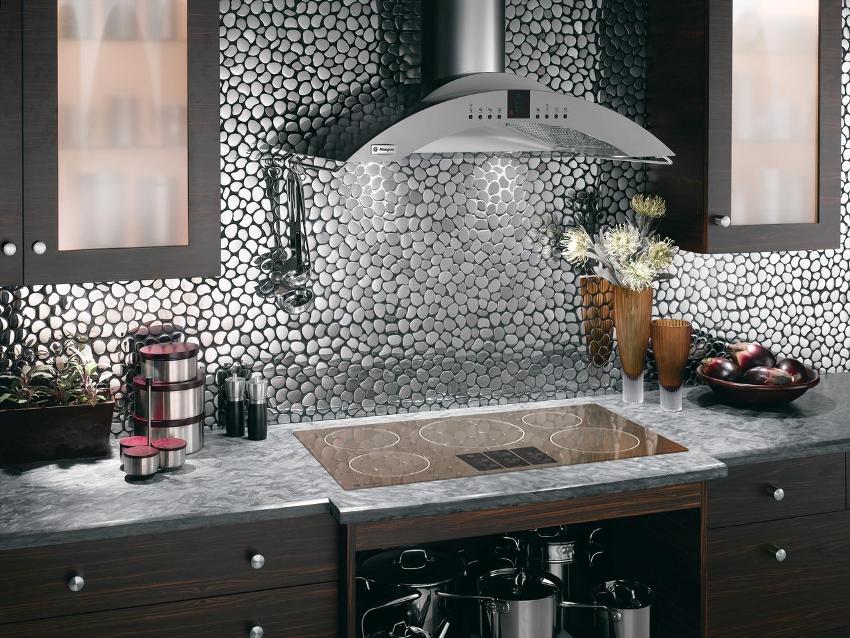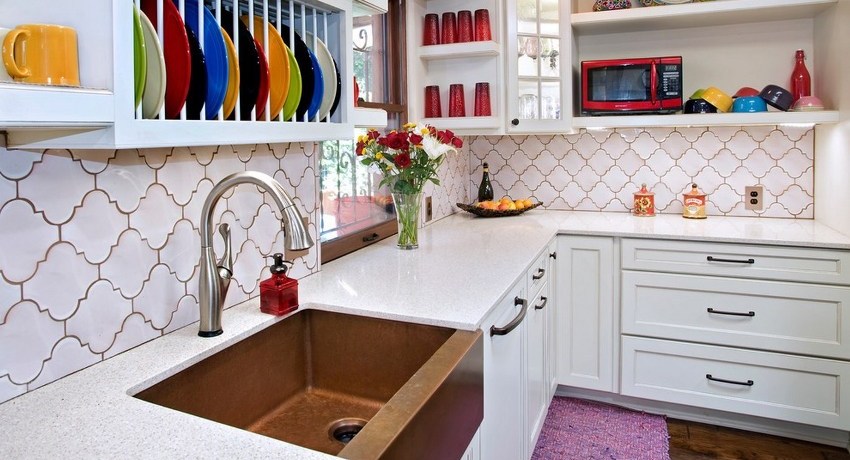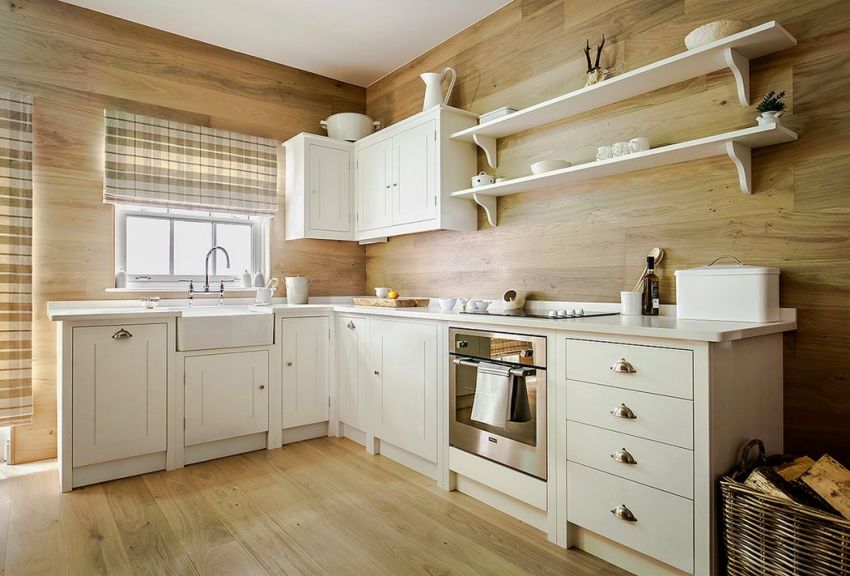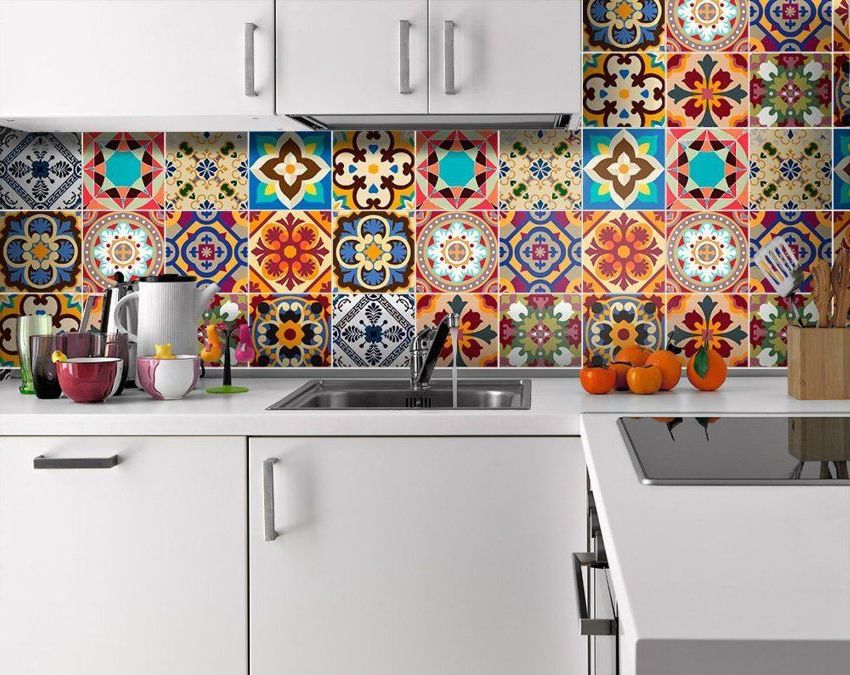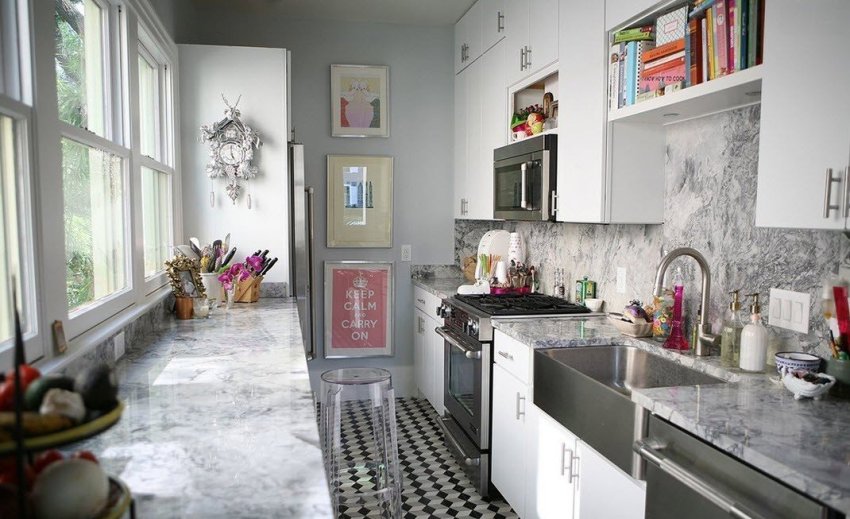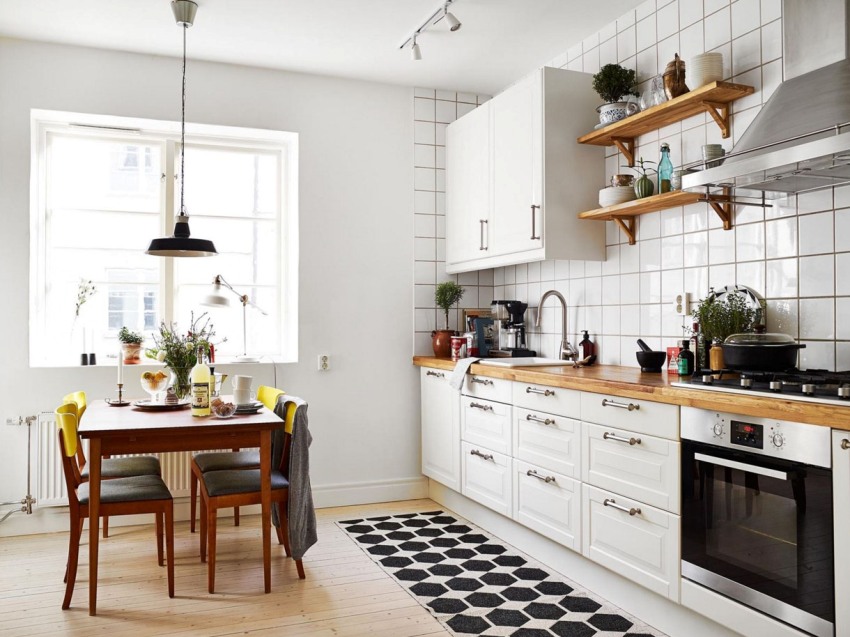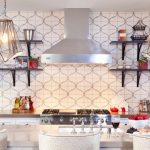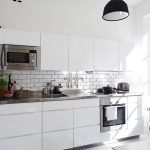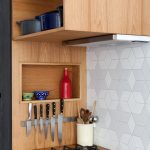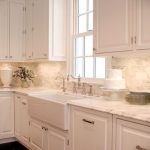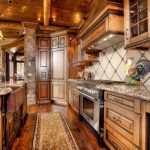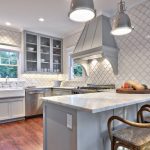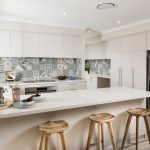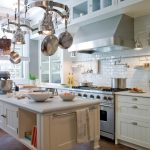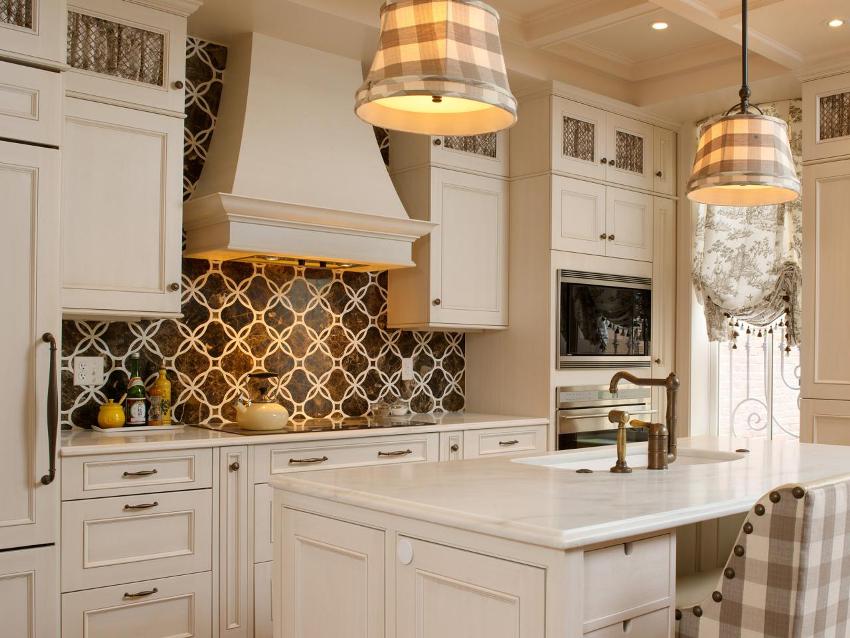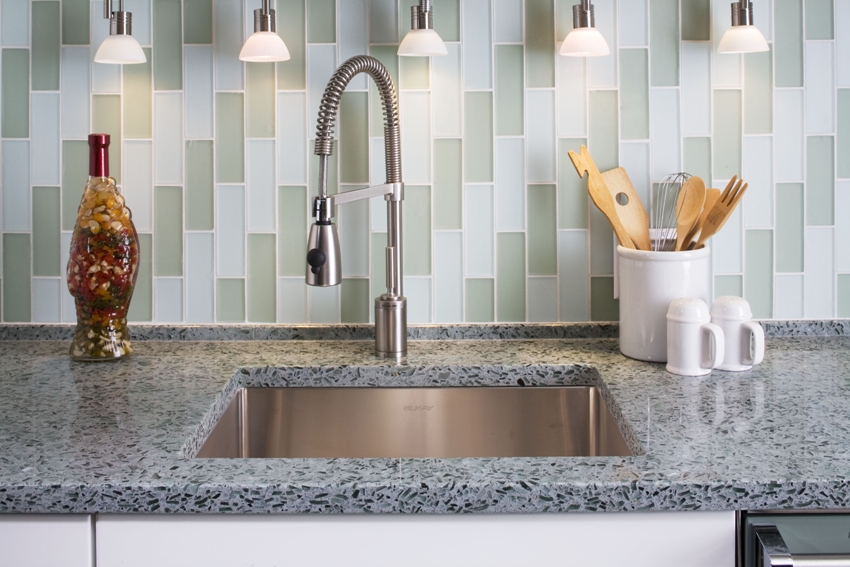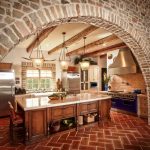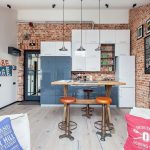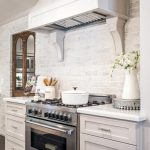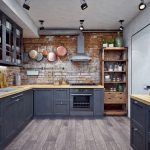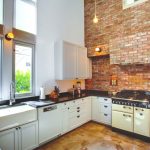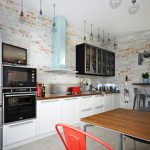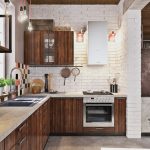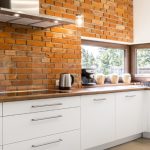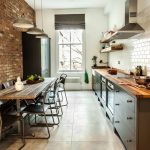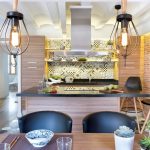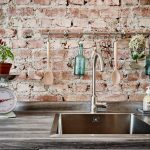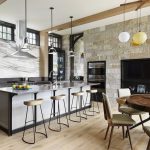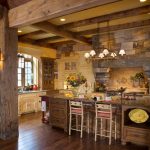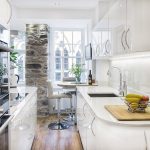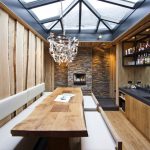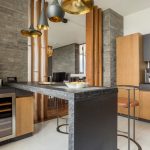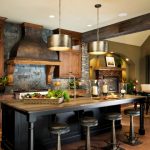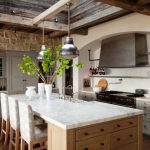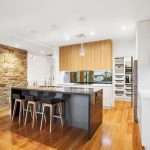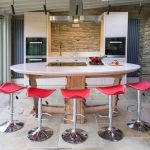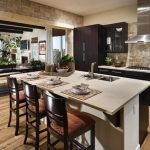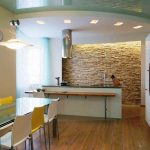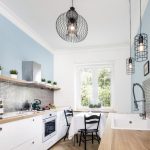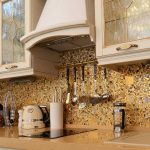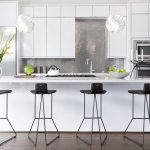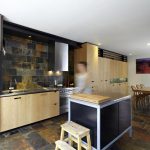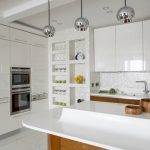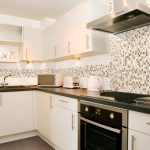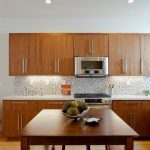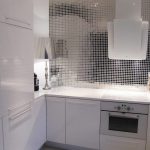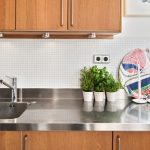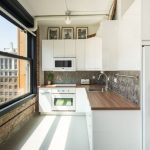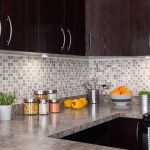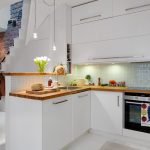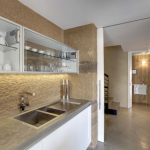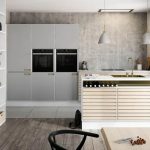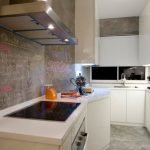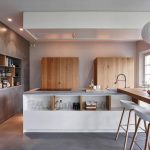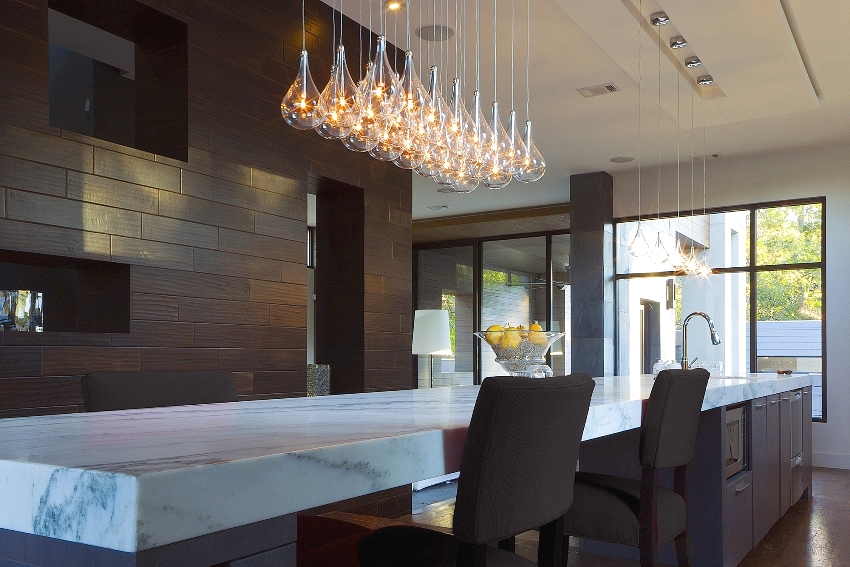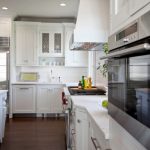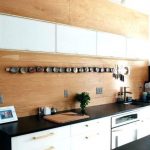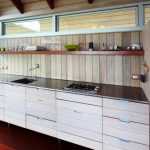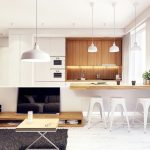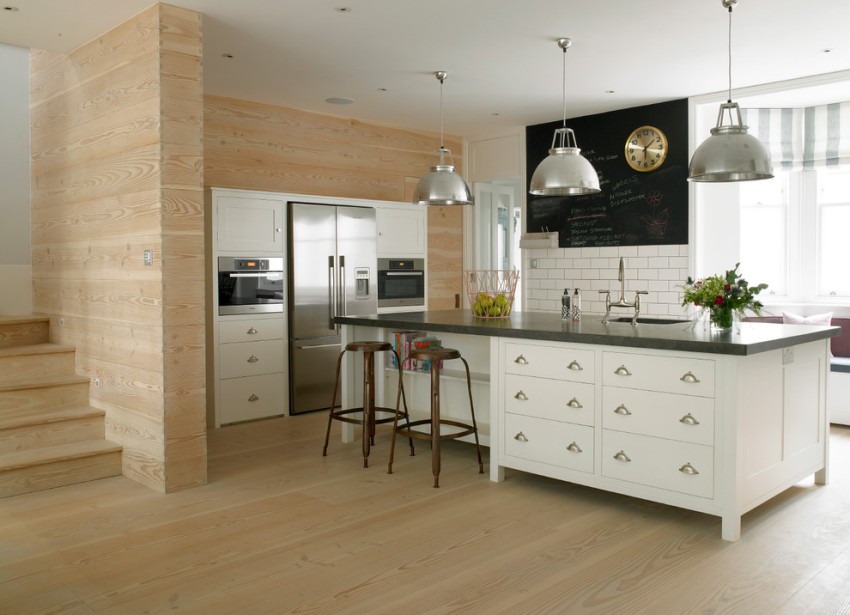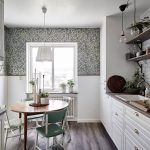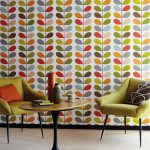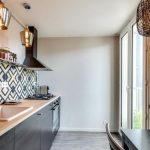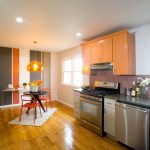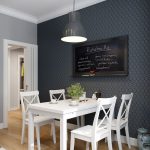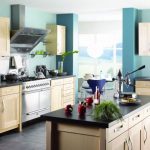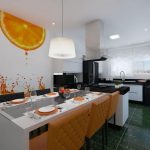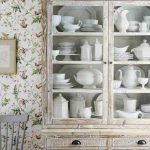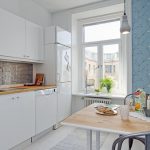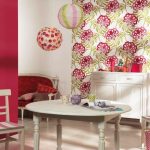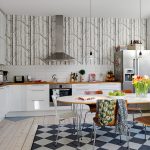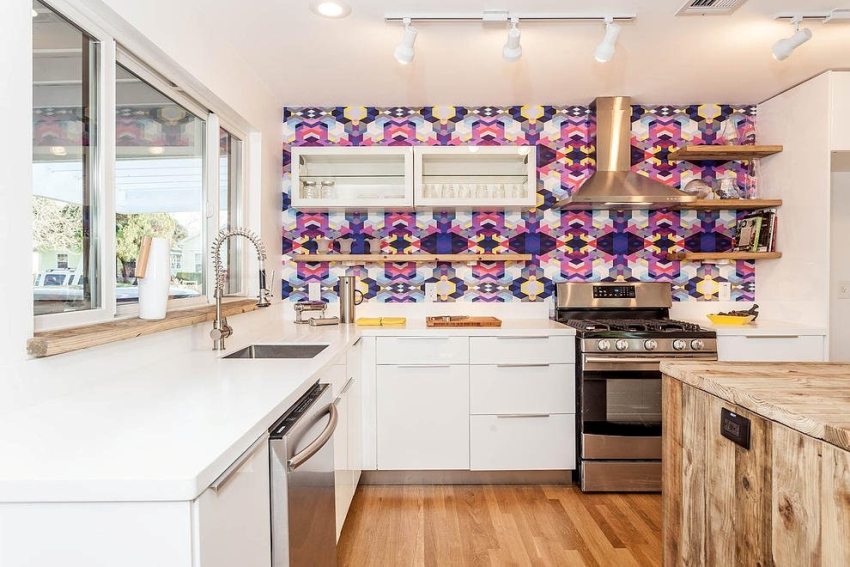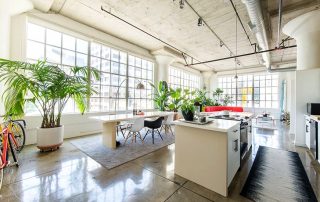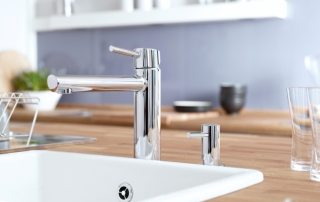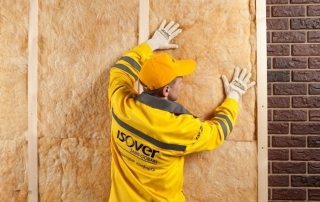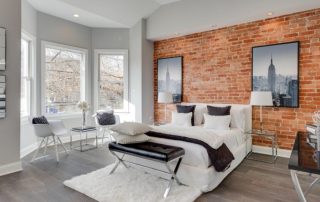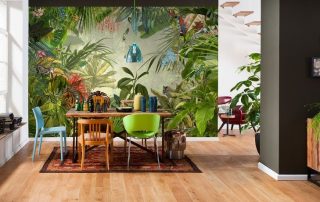The design of individual zones and rooms in a living space requires a special approach. When choosing materials and processing methods, take into account the functional load assigned to the room. Wall decoration in the kitchen requires a special approach: design options imply the use of materials that are practical and resistant to a number of influences. Their variety, selection criteria, rules of use and decoration ideas are described in this article.
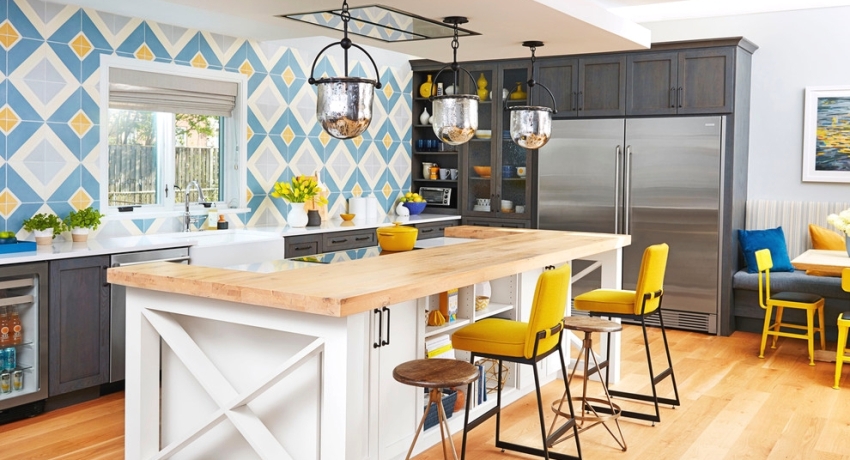
Wall decoration in the kitchen is a creative and complex process that sets the tone for the entire interior
Content
- 1 How to decorate the walls in the kitchen: criteria for choosing materials for different zones
- 2 Tiles on the walls in the kitchen: characteristics and combination options
- 3 Brickwork in the kitchen: photo, wall decoration options
- 4 The use of decorative stone in the kitchen: photo examples of wall decoration
- 5 Kitchen wall decoration: options for using mosaic and flexible stone
- 6 Decorative plaster in the kitchen: species diversity and application rules
- 7 Decorating the kitchen with panels: features of materials and installation
- 8 The use of painting and wallpaper in the interior of the kitchen: photos of original ideas
How to decorate the walls in the kitchen: selection criteria for materials for different zones
The kitchen is a place with specific conditions, characterized by changes in temperature, humidity and increased pollution. Therefore, in the design of the premises, practical and decorative qualities must be harmoniously combined.
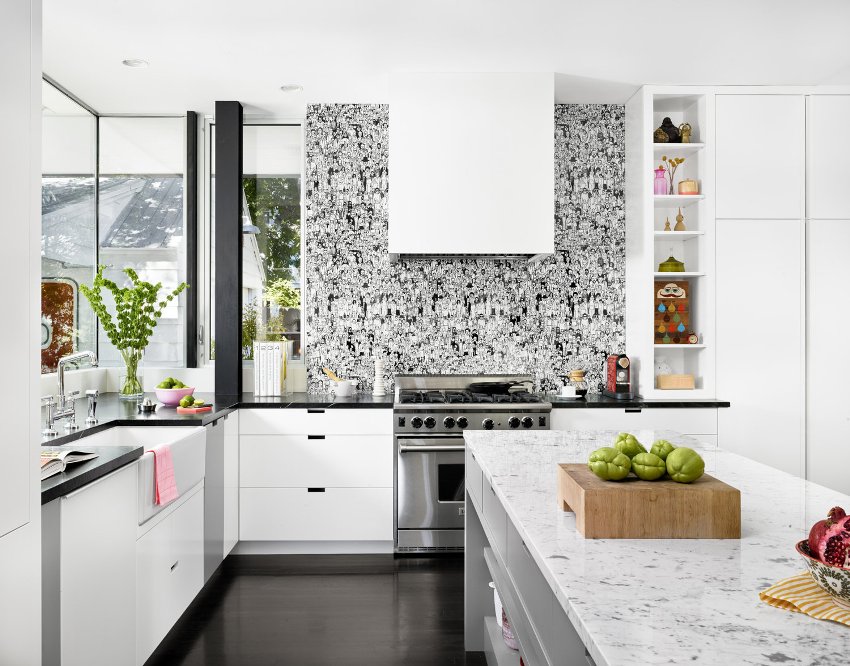
The kitchen belongs to rooms with difficult conditions, therefore, the requirements for finishing materials are high
In addition to the main purpose - cooking, the kitchen performs a number of other functions: they eat here, organize family evenings and often receive guests. Functional diversity implies different design of certain areas. It is in the kitchen that the combined use of materials in wall decoration is encouraged.
A variety of options allow you to implement bold ideas and make the interior in this part of the apartment beautiful and practical. Photos of kitchen wall decoration clearly demonstrate this.
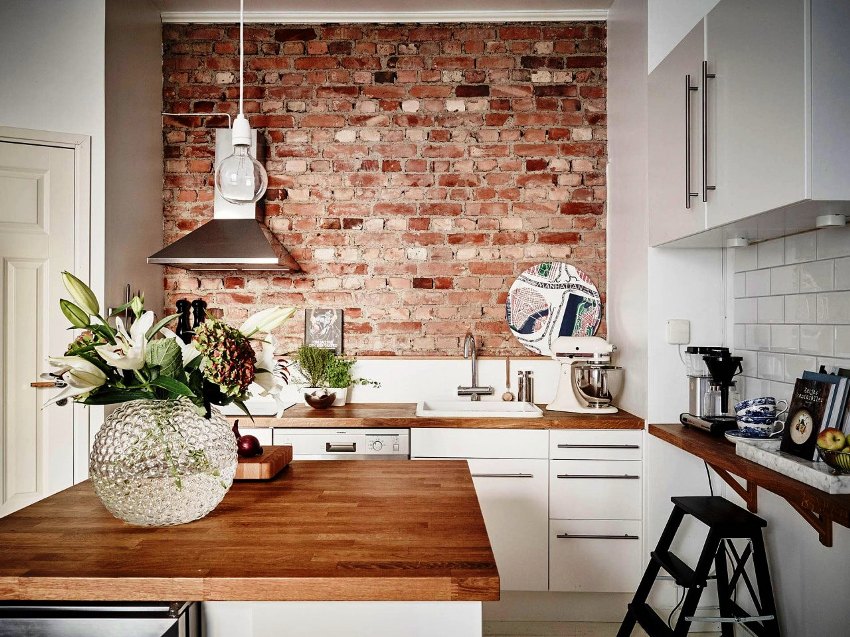
A huge variety of textures, finishing colors allows you to create an interesting and unusual space in the kitchen
Decoration materials for walls kitchens: requirements and selection criteria
When choosing materials for decorating walls in the kitchen, you need to take into account the general design of the apartment and the conditional division of the room into a working and dining area. The key selection criteria are functional features, the specific microclimate of the kitchen and the performance characteristics of the finish.The ease of use and durability of the repair depends on what the walls in the kitchen are covered with. The basic requirements for materials for finishing kitchen walls are as follows:
- resistance to moisture, temperature and steam;
- practicality, consisting in the strength and integrity of the coating when exposed to detergents and cleaning agents applied in order to remove stains from grease and burnt;
- hygiene of the coating, which excludes the possibility of the appearance and reproduction of various microorganisms;
- harmony - materials should correspond to the tones and structure of kitchen furniture, ceiling, floor and appliances, because the general appearance and comfort of the room depends on what the walls in the kitchen are decorated with;
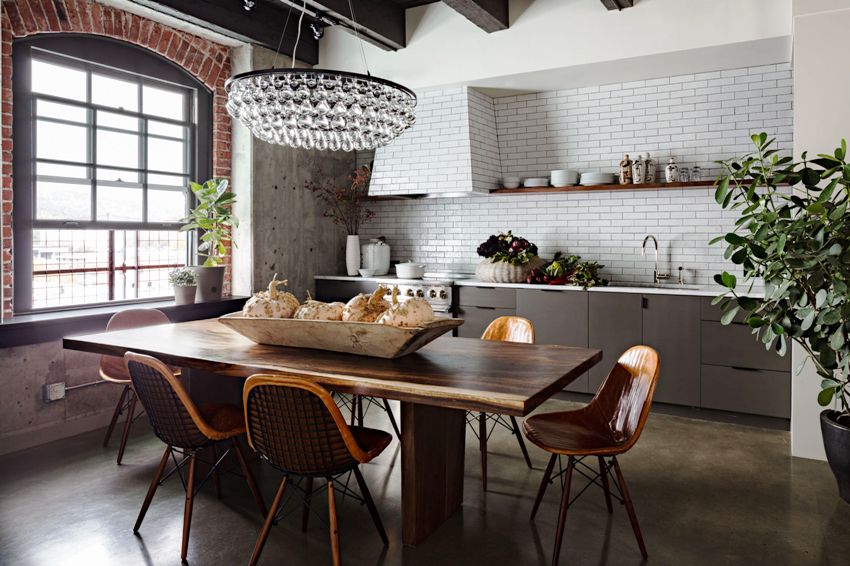
Properly finished walls in the kitchen should wash well and not deteriorate under the influence of water
- aesthetics - the walls in the kitchen, as in other rooms, should please the eyes of the inhabitants of the apartment.
Useful advice! You should not start work on wall decoration without a project and calculations of the amount of required materials. In case of a shortage, it will be difficult to buy exactly the same wallpaper or tiles.
Variety of materials for wall decoration in the kitchen: photo options
Based on the described requirements and characteristics, most often used in decorating kitchen walls:
- ceramic tiles;
- brickwork;
- decorative and natural stone;
- wall porcelain stoneware;
- metal, ceramic and glass mosaics;
- decorative plaster;
- PVC coated MDF panels;
- wallpaper;
- painting.
In the kitchen, as a rule, two types of wall decoration are used. The materials of the working area and the so-called "apron" should be as practical as possible. Lighter coatings can be used in the dining area, but they should also be easy to clean. This method of combining the coating in different zones will give the maximum effect and help to achieve the ideal level in the combination of decorative and technological characteristics.
Each of the listed materials has its own characteristics - positive and negative. The best way to decorate the walls in the kitchen is to choose the owners who rely on their own taste and financial capabilities. For this choice to be correct, you need to know the features of each of these options.
Tiles on the walls in the kitchen: characteristics and combination options
Faced with a choice of what can be used to decorate the walls in the kitchen, apartment owners very often tend to use tiles. It is the most common decoration material in the kitchen, as it has an ideal value for money.
Ceramic tiles have a coating of various structures, it can be smooth and glossy, textured and matte. Tiles are most often used to decorate a working wall or an area of the so-called "apron", which is possible due to its following properties:
- strength and shock resistance;
Related article:
Tile kitchen apron: photos of original ideas and tips for choosing
Tile selection criteria. Ideas for original surface designs. Most popular tile manufacturers
- ease of washing using chemical cleaning agents;
- resistance to moisture, steam and high temperature.
In addition, with the help of well-chosen tiles, you can create a harmonious image even in a small space. But for this, an apron made of ceramic tiles should be combined in color and texture with a kitchen set, creating a single composition.Ideally, the shades of the apron match the color of the countertop.
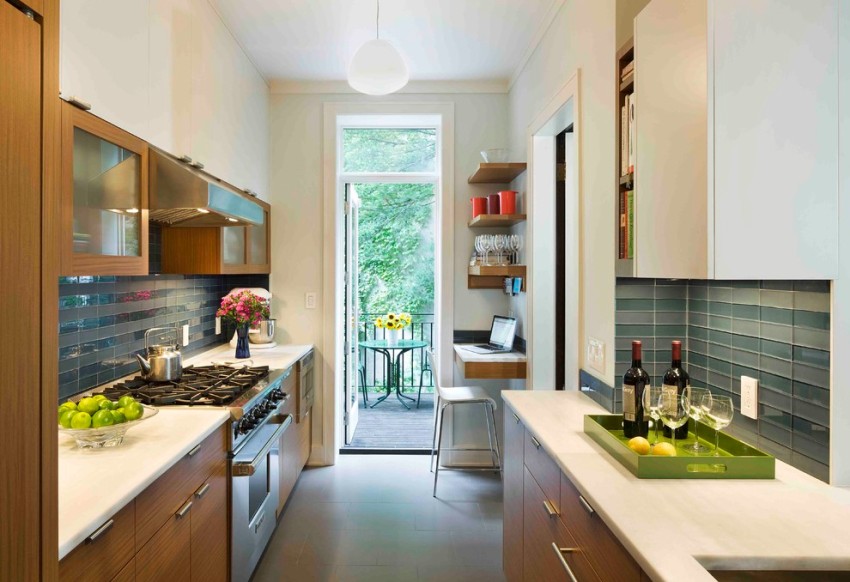
An important advantage over other finishing materials is that the tiles are not exposed to high temperatures
Important! The size of the ceramic tiles is of great importance in creating a beautiful combination. Large, as a rule, contributes to a visual decrease in the room, and small tiles, on the contrary, visually enlarge the kitchen.
In the decoration of the walls of the kitchen, material with a small pattern or solid color is better suited to avoid variegation. Decorative elements should also be dosed. If the emphasis is on the tiles, then other areas should be less bright, without contrasting patterns.
Features of the choice of ceramic tiles: photos of a kitchen with tiles
When choosing ceramic tiles, you should consider some rules. In particular, even in the store, it is necessary to check the surface of the material for integrity and make sure there are no cracks, chips and curvature. You need to buy tiles with a 10 percent margin. For example, if the calculations showed that 5m² is required, then it is recommended to purchase 5 and a half squares. In this case, the number of tiles themselves may be different.
The surface of the wall tiles must be flat, smooth, without roughness. Otherwise, caring for it will be problematic: it will take additional time and effort to wash off the grease and carbon deposits in the recesses. Light and monochromatic tiles are also difficult to clean, while dark tiles accentuate cracks and flaws.
Nowadays, tiles are practically not used to decorate all the walls in the kitchen. More often they decorate a kitchen apron, and the rest of the walls are decorated with plaster or wallpaper. Wall and floor tiles must be selected from the same collection.
This, at first glance, versatile material has one significant flaw: over time, it becomes more difficult to wash it due to the many seams that contribute to the accumulation of grease and burning. Therefore, for finishing the working area, an apron made of glass or a special panel made of plastic is increasingly being chosen.
Brickwork in the kitchen: photo, wall decoration options
Lovers of Art Nouveau and loft style often leave ordinary brickwork without finishing. In order to give an appropriate design and aesthetic appearance to an unplastered wall, it is necessary to apply special products to it, which will also serve as a protective layer. As a wall covering, you can use special panels or wallpaper imitating brickwork.
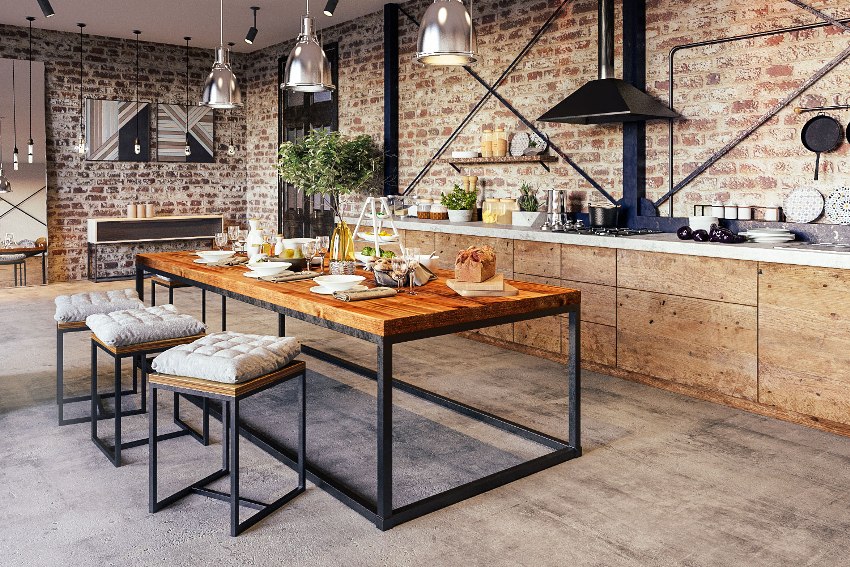
Loft style kitchen using brickwork as wall decoration
As a finishing material, brick has many advantages. It is durable, moisture and heat resistant, so it can last long enough. Brickwork is ideally combined with a variety of materials and looks equally beautiful in both modern and classic interiors. In addition, the brick has an affordable cost and does not require additional (except for coating) finishing. Brick blocks provide good sound and heat insulation. Even a person who has no construction experience can ennoble a brick wall.
Important! Brickwork of all walls in the kitchen is possible only in large and spacious rooms. Such decor in ordinary apartments is often used as a design accent in the design of a certain area. The most popular option for decorating a brick wall is coating with light waterproof paint.
Application decorative stone in the kitchen: photo examples of wall decoration
Despite the fact that the artificial material actually just imitates a real stone, it has certain advantages.For example, it is significantly lighter than the original, making it easier to ship and install. Like its natural counterpart, it is durable, as it has increased strength indicators.
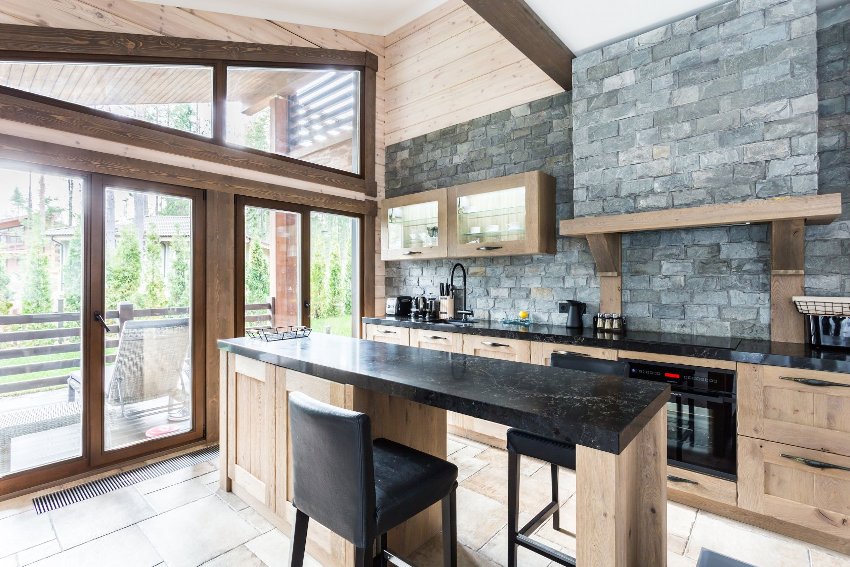
Non-standard, but original solution - decorating the walls in the kitchen with decorative or natural stone
In addition, the decorative stone is environmentally friendly, and its coating does not promote the growth of bacteria and fungi. The material is affordable. The main advantage is ease of care, it is easy to clean it with a regular brush using detergents.
However, as in other rooms, the use of decorative stone in the kitchen can only be partial. The walls completely tiled in this way will turn the room into a medieval castle. With its help, individual moments or elements of the interior are accentuated.
The most successful solution in decorating a kitchen with decorative stone is inserts in the corners or on the wall, cladding around a furniture set or a specific area. At the same time, it goes well with various decor materials and can be an excellent alternative to wallpaper or tiles.
Wall-mounted porcelain stoneware in the decoration of the walls of the kitchen: photo options
Porcelain stoneware appeared quite recently, but managed to gain a positive reputation in the construction industry as a practical and aesthetic material. It is used in different rooms, but it is especially popular in kitchen design.
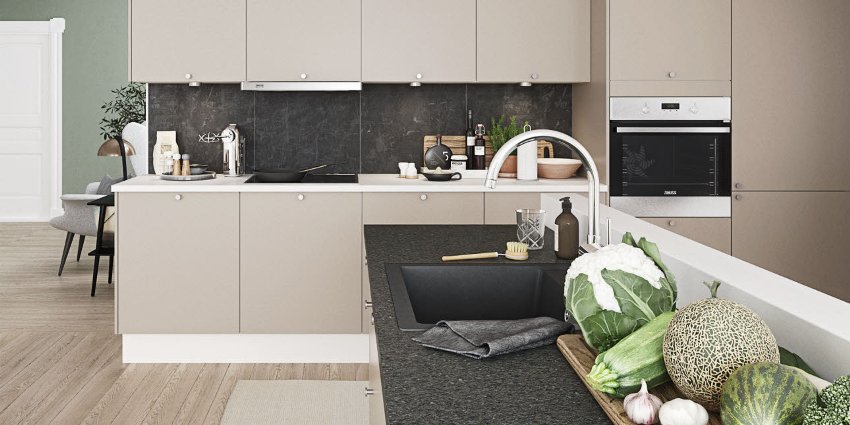
Porcelain stoneware is a highly durable material that can withstand changes in humidity and temperature
The main advantage is easy cleaning from grease and various stains using elementary detergents. The material is antistatic to prevent dust accumulation. The color of the porcelain stoneware coating should be in harmony with the overall design of the kitchen. It should be borne in mind that on a light surface, pollution is more noticeable, and dark walls reduce the space. It is better to choose material in a neutral color. It is better to refuse a matte or embossed surface, since such a coating is more difficult to wash.
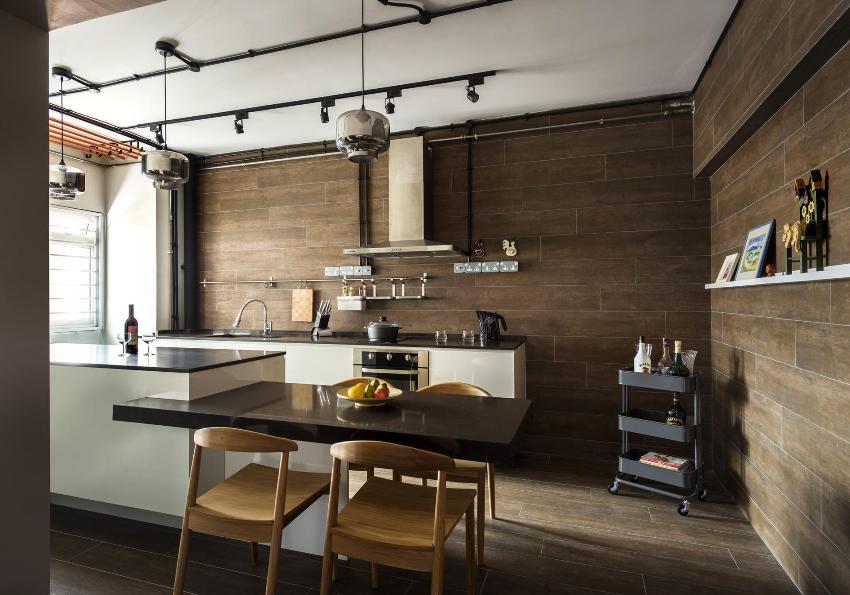
The richness of the color palette of porcelain stoneware tiles allows you to embody in kitchen interior both traditional and creative design solutions
Ceramic granite also has favorable material characteristics: it is cheaper than decorative, and even more so natural stone, although it has the advantages of noble materials. Recently, the kitchen is widely used countertops and sinks from porcelain stoneware.
Useful advice! Decorative inserts from porcelain stoneware tiles can be an excellent addition to the background design of various coating options. For example, a beautiful panel will help create a decorative accent or highlight a functional area.
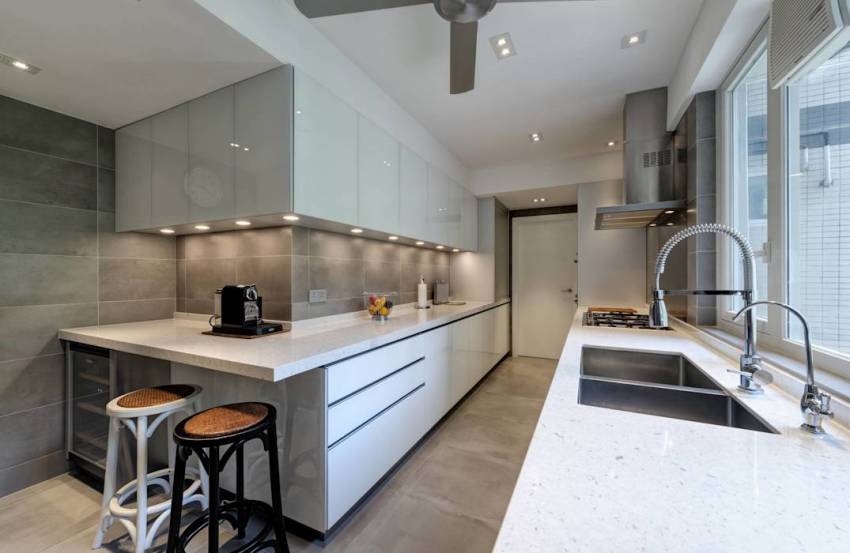
Porcelain stoneware tiles require minimal maintenance, since the material does not collect dust, it is enough to wipe the surface from time to time with a damp sponge
Wall decoration in the kitchen: options use of mosaic and flexible stone
Mosaic gives the kitchen wall a special "zest" or draws attention to any part of the room. The material has various colors, patterns and textures. Various raw materials are used for the manufacture of mosaics: plastic, glass, mirror, metal, ceramics, as well as natural stone and wood. The mosaic fabric is resistant to temperature changes and other influences. Multiple seams create difficulty in leaving.
The material has various shapes. These can be circles, diamonds, ovals, rectangles. The most popular are classic squares. Recently, a variety in the form of a solid canvas has been especially common. More often it is used to cover the work wall and apron. It also looks great on the countertop, and the mosaic wall panel will become an original decoration of the room.
Flexible stone is a fairly popular material preferred by many modern designers.This is a successful synthesis of natural material and artificial base. In the production of flexible stone, sandstone is used as a raw material, which is carefully and evenly applied to glass canvas... The material is produced in the form of two-meter rolls or tiles of various sizes.
The main advantages of the material are environmental friendliness and ease of installation. Thanks to its flexibility, it can be given any shape, thus realizing various design ideas. Additional advantages are provided by fire safety and resistance to temperature effects. Flexible stone can withstand temperatures from -45 ° C to 600 ° C.
Decorative plaster in the kitchen: species diversity and application rules
Decorative plaster is often used in the decoration of kitchen walls. At the same time, almost all of its types are suitable in the design of the dining area, the main ones are:
- structural;
- textured;
- Venetian.
The base material for application are polymer, silicone and silicate solutions or mixtures on a water and anhydrous basis, with admixtures of marble chips or lime-sand particles. The main advantage is the affordable price. Various design options using this type of finish clearly demonstrate photos of decorative plaster in the kitchen.
The most popular types of kitchen plaster are Venetian and Moroccan. They allow copying of natural stone and give the finish the texture of marble or travertine. Using the sgraffito technique, they create the illusion of appliqué or aged surface, as well as imitation of silk and velvet. Depending on the style chosen, the walls are decorated with bark beetle plaster or create an analogy to a concrete wall.
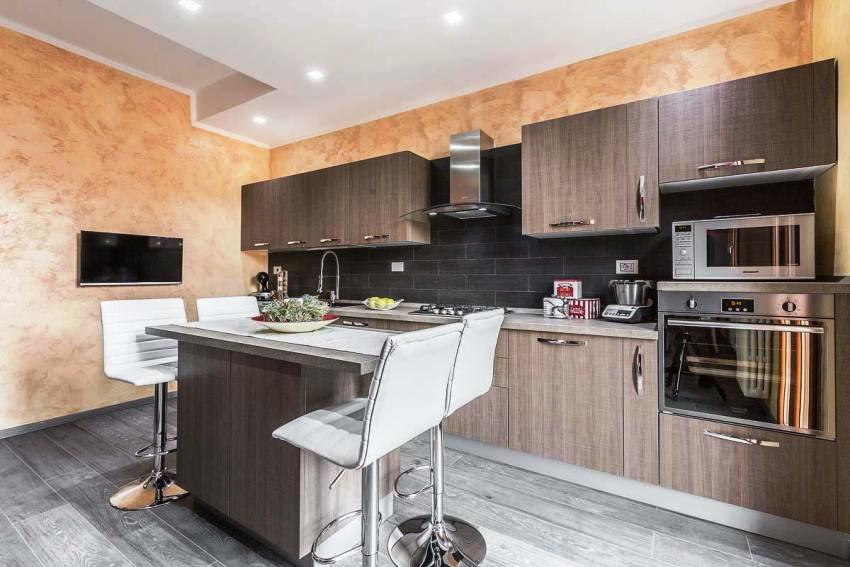
An important advantage is that the application of decorative plaster does not require an absolute leveling of the walls.
Useful advice! In order to protect the plastered wall in the kitchen from moisture, grease and mechanical stress, it is recommended to cover the surface with a special protective varnish.
Kitchen paneling: material and installation features
Multiple photos of wall decoration with MDF panels, which are quite often found on the network, indicate the popularity of this option for decorating kitchen walls. This recognition is due to the density and durability of the material, as well as its resistance to moisture and temperature extremes. This environment prevents the development of microorganisms and bacteria.
Different types of panels are used for kitchen walls, in particular:
- lined with veneer;
- painted;
- PVC coated.
Most often, MDF panels are used in the production of furniture facades, but decorating the walls with their help also looks quite attractive - photos of panels in the kitchen are confirmation of this fact. PVC-coated panels are often used for wall cladding, since the material is easy to clean and at the same time it is resistant to household chemicals.
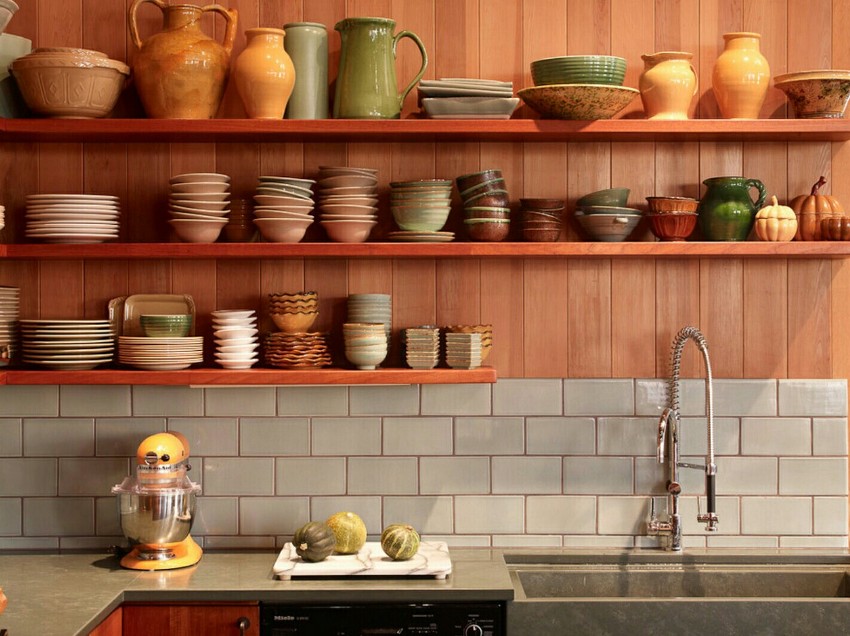
Plastic panels for decoration have a specific appearance, but they look beautiful and stylish in the kitchen
Useful advice! The panels have a drawback in the form of low resistance to temperature influences, therefore, for the purpose of fire safety, it is not recommended to place the material near sources of open fire.
Plastic panels or wooden lining in the kitchen are also widely used. The popularity is due to moisture resistance and electrical safety. At the same time, the color range of the proposed models allows for various interior styles. In addition, panels are one of the most affordable materials in terms of price. It is the lining that is ideal for those who are looking for a budget option in deciding how to decorate the walls in the kitchen in the apartment.
Photo panels for the kitchen show various options for wall cladding. There are two main ways to install plastic panels:
- The frame is assembled from profiles or beams. The panels are inserted into special cells.
- Bonding to the wall. This method requires a lot of glue.
The choice of the appropriate method depends on the individual characteristics, the structure of the walls and the specific situation.
The use of painting and wallpaper in the interior of the kitchen: photos of original ideas
Wallpaper is a traditional and perhaps the most popular finishing option in any room. They are also irreplaceable in the case of kitchen walls. In this case, you should immediately exclude the use of ordinary paper wallpaper, as they absorb moisture and odors. Therefore, in rooms with high humidity and specific aromas, they often use liquid, vinyl, non-woven, glass fiber. The best option is vinyl wallpaper. Photos of kitchens with this type of finish demonstrate how successful such a choice is.
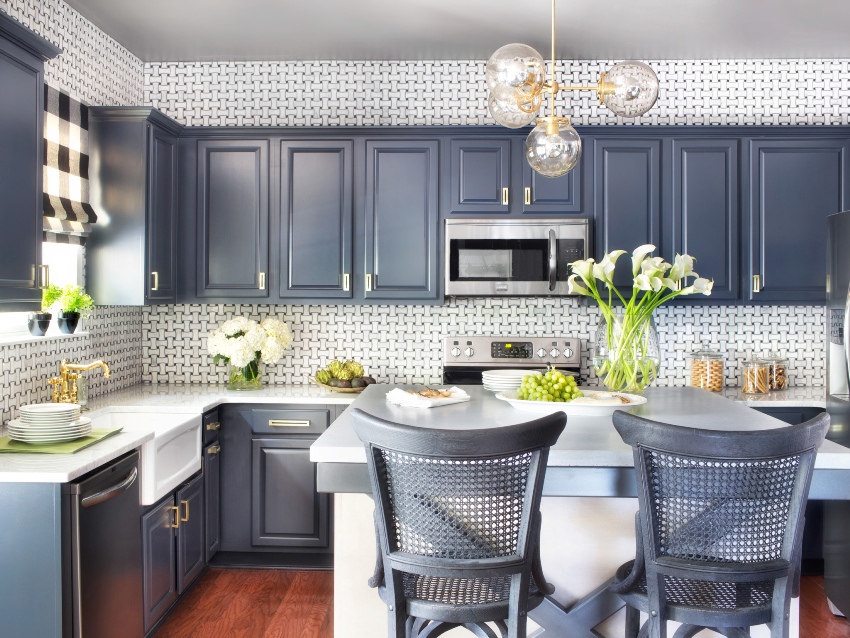
Ordinary wallpapers will not work in the kitchen, so it is better to use the following types: liquid, glass wallpaper, vinyl or non-woven
The vinyl coated material, which is a PVC film, is easy to clean using a variety of detergents. The wallpaper, thanks to the protective layer, is resistant to moisture, dust, soot. In addition, they do not come off when exposed to steam.
Non-woven kitchen wallpaper is also widely used. The photo is a clear confirmation of this. The main advantage is strength and the ability to hide the flaws of the walls. The material is easily breathable and does not come off even at high humidity. An additional advantage is the possibility of reusable painting.
A new and trendy design option is liquid wallpaper in the kitchen. Owner reviews testify to their aesthetics and practicality in use, since they practically do not deform and do not scratch. They are produced in bags, not rolls; they are applied to the walls, not glued.
Glass fiber is made of special fiberglass. The material is difficult to apply, so you need to use a special glue. At the same time, fiberglass cloth is resistant to physical influences, characterized by fire safety, strength and reliability.
Useful advice! To hide uneven surfaces or communications, panels are often used on the walls instead of wallpaper.
Painting is the most affordable finishing method in terms of price, but it is not suitable for covering all surfaces. Most often brick, plaster and certain types of wallpaper are painted. For covering kitchen walls, it is better to choose a moisture-resistant paint, which, after drying, creates a glossy finish. Unlike matte, such a surface is much easier to wash. Any painting has a serious drawback: it is not able to hide the unevenness of the walls, so any flaws will be noticeable.
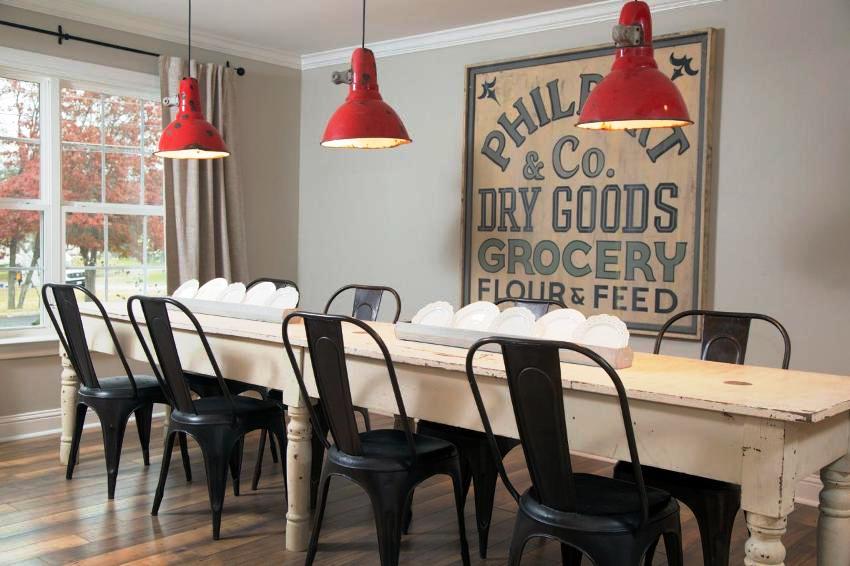
When choosing wallpaper for painting for the kitchen, it is recommended to give preference to those types that are suitable for repeated staining
As you can see, there are various ways to solve the problem of how to decorate the walls of the kitchen. When choosing materials, you need to be guided, first of all, by your own taste and financial capabilities; take into account the general design of the apartment and zoning rules. The options considered in the article prove that even with the help of inexpensive and standard materials, you can create a beautiful interior with your own hands in the most functional room - the kitchen.
